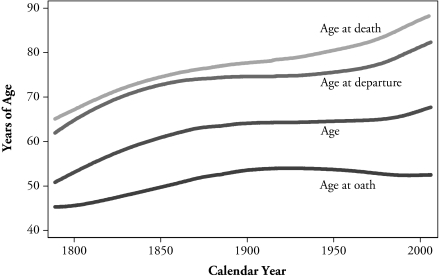As people discuss whether Justice Roberts avoided politics by siding with the left side of the Court or instead yielded to political pressure to change his vote, I want to point to an article that I posted on SSRN a couple of days ago. It shows that Supreme Court justices do tend to act politically in one respect: They tend to retire or take senior status strategically to favor the party of the president who appointed them.
My co-author, Rafe Stolzenberg, and I also plot how much older the justices have become in the last half-century.
Figure 1
Means of Sitting Justices’ Age at Oath, Age, Eventual Age at Departure From Court, and Eventual Age at Death (in order listed) Versus Calendar Year
Note: Lines are fitted and smoothed by Cleveland’s locally weighted regression (LOWESS).
Note that, while the age at oath has changed little in the last 150 years, the age of the sitting justices and the eventual age at departure have both increased in the last half-century (the latter markedly).
We also made a large number of methodological improvements on prior work. For example, most studies had assumed that the longer justices served, the more likely they were to retire. If that were true, that would be a strange job. In most jobs, once people settle in, they are more likely to stay, rather than more likely to leave. Indeed, our analysis shows that it is not until justices reach their 25th year of tenure on the Court that an additional year on the Court makes them more likely to retire. Before that, each additional year of service makes them instead more likely to stay on the Court. Some of the odd results of prior studies on strategic retirement might in part reflect their using a linear version of the variable longevity of tenure on the Court. We used fractional polynomials to (nearly optimally) determine the shape of the longevity curve to fit.
Moreover, we introduce the first good measures of justices’ health when they retire. We know the date of death for all retirees except the most recent ones. There is substantial demographic research suggesting that knowing the years left to live is an excellent measure of both actual and subjective health on the date of retirement.
Our paper, “Retirement and Death in Office of U.S. Supreme Court Justices,” can be downloaded at SSRN.
More here.
UPDATE: On the effect of more years on the job:
The effect of an additional year of tenure becomes increasingly negative through the 15th year on the Court, when an additional year of tenure decreases expected retirement odds by 12.5%. Thereafter, the negative effect of an added year of tenure weakens annually, until it becomes positive at 25 years. At 28 years of tenure, an additional year increases expected retirement odds by 11.2%. At 29 years, the increase is 15.8%. . . .
Tenure effects on retirement follow the “bathtub distribution” typical of orderly failure time processes. Justices start their service with elevated risk that removes individuals unsuited for the position (called “manufacturing defects” in failure-time studies), followed by a long period of low retirement rates (“regular service”), after which failure rates rise sharply (“end of service life”).

Comments are closed.